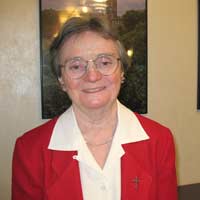Margaret Ellen Flannelly, RSHM
Marymount Alumnae Chaplain
 I have been part of Marymount’s history, as a political science teacher and academic administrator, for at least 40 of its 100 years. As a Religious of the Sacred Heart of Mary, it has been a challenging and life-giving ministry for me. I am presently serving as chaplain to the Marymount alumnae, a new position established by Fordham president Joseph M. McShane, S.J., to stay connected with the college’s roughly 10,000 alumnae. So as I begin this ministry, I reflect on the past.
I have been part of Marymount’s history, as a political science teacher and academic administrator, for at least 40 of its 100 years. As a Religious of the Sacred Heart of Mary, it has been a challenging and life-giving ministry for me. I am presently serving as chaplain to the Marymount alumnae, a new position established by Fordham president Joseph M. McShane, S.J., to stay connected with the college’s roughly 10,000 alumnae. So as I begin this ministry, I reflect on the past.
The Religious of the Sacred Heart of Mary was founded in 1849 in Beziers, France. As it spread to other countries, it began to put most of its emphasis on the ministry of education—especially for girls and young women, be they wealthy or poor, taking the words of Jesus in John 10:10, “I have come that they may have life and have it abundantly.”
Marymount College, Tarrytown, was the vision of Mother Joseph Butler. She was a wise, dynamic woman, Irish born, who professed as a Religious of the Sacred Heart of Mary in Beziers. She was an educator in Portugal for almost 25 years before coming to the United States in 1903 and founding Marymount in 1907. As early as 1917, in an effort to expand Catholic higher education for women, courses in law and political economy were added to the existing courses in history, philosophy and languages. To promote these offerings, an ad appeared in The New York Sun stating: “The time has gone by when to be feminine meant to be helpless. The world has never needed womanly intelligence and sympathy so much as it does today.” This statement resonates even in the 21st century.
History professor Kathleen Connell, RSHM, Ph.D., in her research on Mother Butler, highlights two perspectives of her educational vision:
“… the close-up reality where each student’s personal growth, personal relationship with God, and intellectual and cultural development was the focus of her energy, and the far reaching, expansive global reality which she anticipated, where students of diverse nationalities, languages and even religions would be linked in an international educational enterprise.”
In the final months of Marymount’s existence as a college, Gerard Reedy, S.J., the academic dean, asked faculty to write short essays describing their memories of Marymount and their teaching experience. A book titled Good Teaching, Memories of Marymount was published. The following are thoughts from a few of these essays that convey their spirit—joyful, sad and appreciative of their professional experience as faculty and their respect for the students they taught.
“… we should remember the warm and vibrant Community at the College that we all helped cultivate. Let us recall the charitable efforts, the sense of service, the social gatherings … Let us remember the classes, the exhibitions, the recitals, the readings, the special lectures. Let us honor all the years of student and faculty endeavor and achievement: let us revere all those who made that possible in a beautiful place.”
—Maria Chamberlin-Hellman, Ph.D., art history
“The lay faculty, with its religious and cultural diversity, have shared with the RSHM in the constitution of Marymount’s culture of caring and quality…”
—Thomas Cloonan, Ph.D., psychology
“In my contact with hundreds of students over many years, I was delighted and privileged to be with them, hopefully imparting knowledge, but assuredly learning from them. The richness of their backgrounds, the variety of their talent, and the tenacity of their pursuits enriched my understanding, elicited my best effort, and incited a joyful hope within me. We indeed were in it together.”
—Marion Fahey, RSHM, business/economics
“Any reflection on Plato’s allegory of the cave leads ineluctably to a meditation on education in general. … The wise person knows that she does not know everything; the fool thinks that she knows all. So the confession of ignorance is the first step to be taken in the journey towards wisdom.”
—Ellen Marie Keane, RSHM, philosophy
“Many … remember the calm, select college ‘in the country’ for largely white middle-class and upper-class women, united by a common faith and ethos, in a relatively traditional curriculum, on a campus permeated by social functions and religious practices. They have seen it transformed into a college for a wide variety of students from different ethnic, social, religious and academic backgrounds.”
—Frank Demers, Ph.D., history and sociology
“At Marymount Tarrytown, we did our best, all of us, so that women might learn freely and live fully, their creative energies liberated to make a difference in the world.”
—Eileen Burchell, Ph.D., modern languages
So be it. Though Marymount College in Tarrytown has closed, Marymounts and the Religious of the Sacred Heart of Mary are still committed to quality education and the pursuit of wisdom. In higher education, we are still affiliated with Marymount Manhattan College; Marymount University in Arlington, Va; Loyola Marymount University in Los Angeles; and Marymount College in Palos Verdes, Calif.
At the elementary and secondary levels, there are six Marymount schools that form an international network and have set goals to continue to develop a relationship with God, a lifelong love of learning, personal growth, a consciousness of social justice and the fulfillment of the RSHM mission, “That all may have life.”
